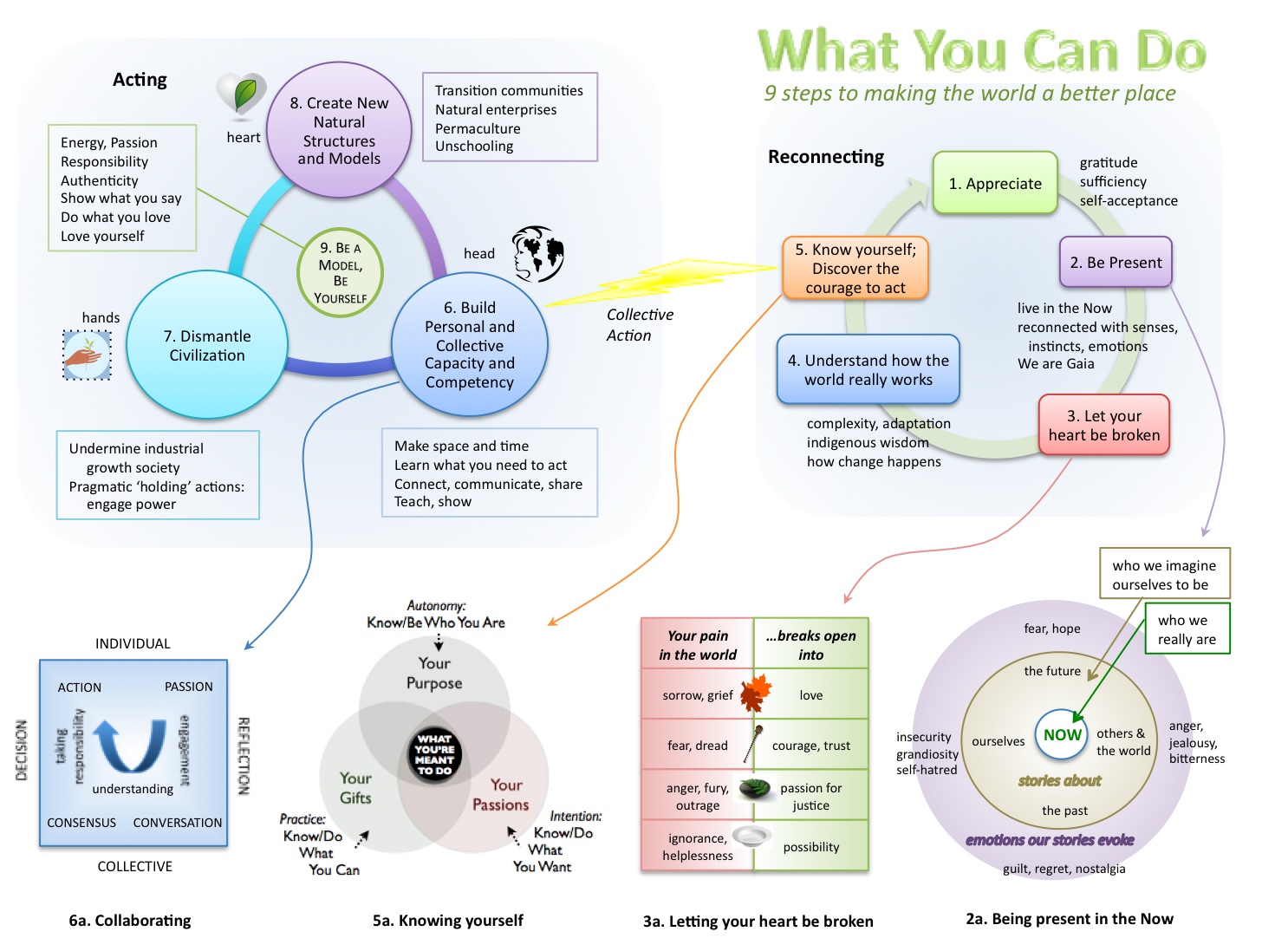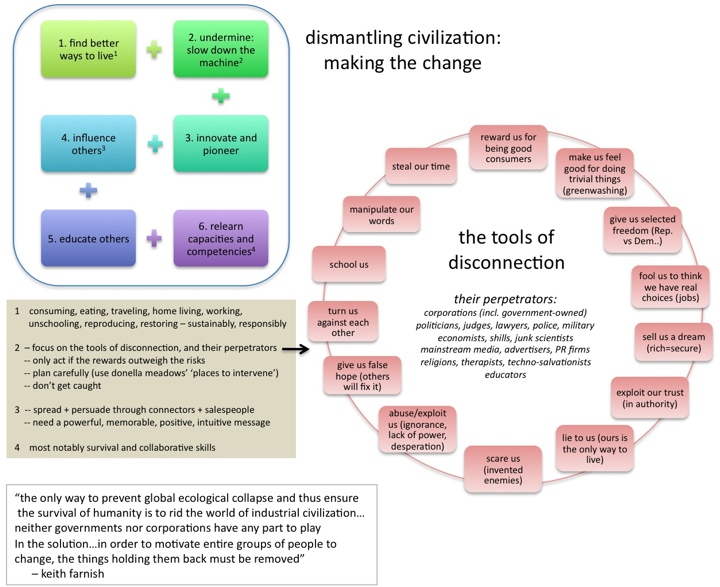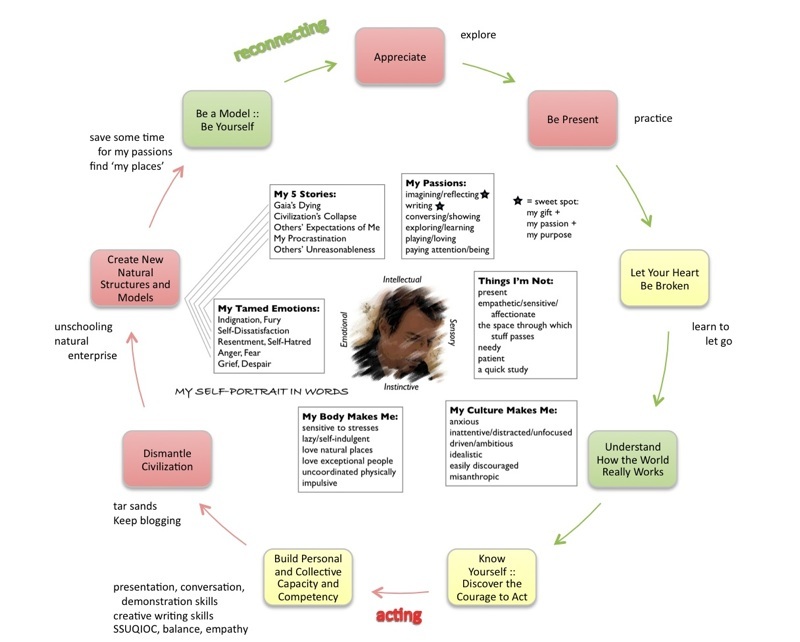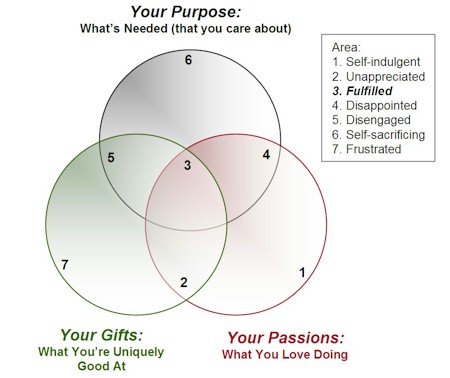
My last few posts have been part of my process of deciding what I’m going to do next, as I prepare to move, to retire, and to become more active in living the ways I have been writing about for six years, my “trying on” different models of the me that I’m becoming. My post on What You Can Do (graphic above) is my attempt at a roadmap of possibilities. My post yesterday (graphic below) drills down Step 7 of this roadmap (the step I’m most unfamiliar and anxious about) in greater detail. And my personal “scorecard” on the 9 steps was in my post at the end of last week: I gave myself a “some progress but a way to go” (yellow) score for Step 5 (Know Yourself and Discover the Courage to Act). I was listening yesterday to a talk (recommended by Chris Corrigan) by Gil Fronsdal on Intentions. In it, Gil makes the point that, before acting, we should know what our intention is for what’s left of our life, and then also for today. The word “intention” comes from the Latin meaning “stretch toward”. An intention is not a hope, dream, plan or aspiration. It is something we are actively working towards, now. So by thinking about our true intention for what’s left of our lives (which may be 37 days, or 37 years), and then about our true intention for today, and aligning those intentions, we can begin to actively “stretch toward” realizing both intentions. My life has been through so many remarkable changes in the past five years I keep having to cycle back with what I’ve just learned about myself, and about the world, and revisiting these intentions. Looking at the 9 steps in the What You Can Do chart, and my progress in each of them, I have to acknowledge some continuing unease and trepidation. Is this really what I want to do with what’s left of my life? Is this really what I’m meant to do? Like my friend Pete McGregor, I keep doubting myself as soon as I think I’ve decided anything. So I thought I’d go back to my Step 5 standby, my “what you’re meant to do” three-circle chart from my book Finding the Sweet Spot: My latest effort at “filling in” the three circles looks like this: My Passions are the things I love doing, copied from my personal scorecard, with the ones that I also do well (I think) shown in the overlap with my Gifts (area 2). I tried to think if I have other Gifts, things I’m uniquely good at, and decided that I’m actually pretty good at “playing” (although non-human creatures seem to appreciate this more than humans), so I moved it to area 2 as well. The three things I put in my Purpose circle (what’s needed that I care about) are the things described in Steps 6-8 of the What You Can Do chart. So then I asked myself: Do any of the things in any of these circle areas (1, 2 and 6) actually belong in area 4, 5 or (ideally) 3? I think there are a few, but not many:
So here I am, still perched on the edge, still not entirely sure what I want to do, what I’m meant to do. But I’m getting close, I think. A little more thought on the intention part, on envisioning what I want to “stretch toward”, what I want to give, and I’ll be there. Category: Activism: What You Can Do
|









Hey Dave –You are so methodical about these things, it just floors me, sometimes. Meanwhile, my approach has been becoming more and more intuitive and organic… all I can say is I hope that as you progress you find just what you are looking for :-)Janene
What experiment could you conduct to disconfirm your worst fears about your life change?
Hey Evelyn: You ask, as you always do, a brilliant question. I guess my problem is not so much fears as it is doubts and, as I wrote about yesterday, split intentions. At its heart, my sense is that what is most urgently needed in the world is high risk-taking activism and patient, persistent, hard work. And I have no passion for either. I feel that I should, but I know myself. I also know I am no Hanged Man, that self-sacrifice is not who I am.I think my role, and my current life-change, is about helping the people who are willing to take risks, and the people who are willing to work hard, to imagine what is possible. The first group I can help to find better, more innovative ways to dismantle (or at least disrupt) civilization than petitions and chaining themselves to bulldozers. The second group I can help to see where they are going and how valuable their hard work is, and give them tools to help them articulate why they’re doing what they’re doing, to others. I need to work collaboratively in tandem with both groups, but I will never really be part of either.I keep asking myself, and others, the question What’s Holding You Back? The only real fear I have, the only thing that is holding me back now, is the perpetual fear of disappointing myself — that I will plunge into my new Help Them Imagine What’s Possible work with energy and enthusiasm, only to discover that’s not what I’m meant to do either. And I suspect the only way I can disconfirm that fear is to actually do it.